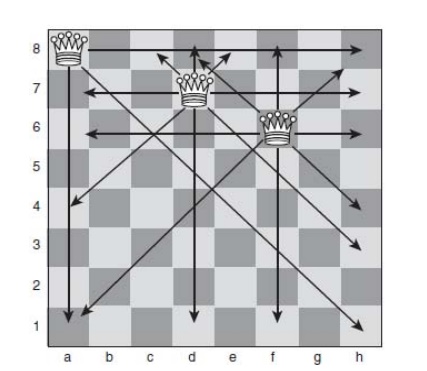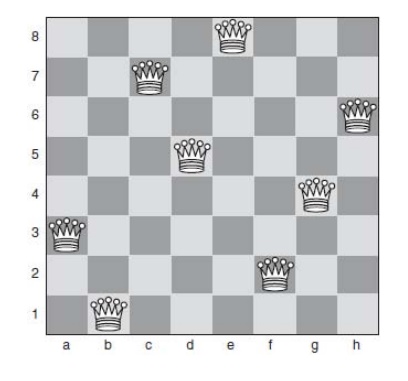Chapter: Artificial Intelligence
Constraint Satisfaction Search
Constraint Satisfaction Search
Search
can be used to solve problems that are limited by constraints, such as the
eight-queens problem. Such problems are often known as Constraint Satisfaction
Problems, or CSPs. I n this problem, eight queens must be placed on a chess
board in such a way that no two queens are on the same diagonal, row, or
column. If we use traditional chess board notation, we mark the columns with
letters from a to g and the rows with numbers from 1 to 8. So, a square can be
referred to by a letter and a number, such as a4 or g7.
This kind
of problem is known as a constraint satisfaction problem (CSP) because a
solution must be found that satisfies the constraints.
In the
case of the eight-queens problem, a search tree can be built that represents
the possible positions of queens on the board. One way to represent this is to
have a tree that is 8-ply deep, with a branching factor of 64 for the first
level, 63 for the next level, and so on, down to 57 for the eighth level.
A goal
node in this tree is one that satisfies the constraints that no two queens can
be on the same diagonal, row, or column.
An
extremely simplistic approach to solving this problem would be to analyze every
possible configuration until one was found that matched the constraints.
A more
suitable approach to solving the eight-queens problem would be to use
depth-first search on a search tree that represents the problem in the
following manner:
The first
branch from the root node would represent the first choice of a square for a
queen. The next branch from these nodes would represent choices of where to
place the second queen.
The first
level would have a branching factor of 64 because there are 64 possible squares
on which to place the first queen. The next level would have a somewhat lower
branching factor because once a queen has been placed, the constraints can be
used to determine possible squares upon which the next queen can be placed.
The
branching factor will decrease as the algorithm searches down the tree. At some
point, the tree will terminate because the path being followed will lead to a
position where no more queens can be placed on legal squares on the board, and
there are still some queens remaining.

In fact,
because each row and each column must contain exactly one queen, the branching
factor can be significantly reduced by assuming that the first queen must be
placed in row 1, the second in row 2, and so on. In this way, the first level
will have a branching factor of 8 (a choice of eight squares on which the first
queen can be placed), the next 7, the next 6, and so on.
The
search tree can be further simplified as each queen placed on the board “uses
up” a diagonal, meaning that the branching factor is only 5 or 6 after the
first choice has been made, depending on whether the first queen is placed on
an edge of the board (columns a or h) or not.
The next
level will have a branching factor of about 4, and the next may have a
branching factor of just 2, as shown in Fig 6.1.
The
arrows in Fig 6.1 show the squares to which each queen can move.
Note that
no queen can move to a square that is already occupied by another queen.

In Fig
6.1, the first queen was placed in column a of row 8, leaving six choices for
the next row. The second queen was placed in column d of row 7, leaving four
choices for row 6. The third queen was placed in column f in row 6, leaving
just two choices (column c or column h) for row 5.
Using
knowledge like this about the problem that is being solved can help to
significantly reduce the size of the search tree and thus improve the
efficiency of the search solution.
A
solution will be found when the algorithm reaches depth 8 and successfully
places the final queen on a legal square on the board.
A goal
node would be a path containing eight squares such that no two squares shared a
diagonal, row, or column.
One
solution to the eight-queens problem is shown in above Fig .
Note that in this solution, if we start by placing queens on squares e8, c7, h6, and then d5, once the fourth queen has been placed, there are only two choices for placing the fifth queen (b4 or g4). If b4 is chosen, then this leaves no squares that could be chosen for the final three queens to satisfy the constraints. If g4 is chosen for the fifth queen, as has been done in Fig 6.2, only one square is available for the sixth queen (a3), and the final two choices are similarly constrained. So, it can be seen that by applying the constraints appropriately, the search tree can be significantly reduced for this problem.
Using chronological backtracking in solving the eight-queens
problem might not be the most efficient way to identify a solution because it
will backtrack over moves that did not necessarily directly lead to an error,
as well as ones that did. In this case, nonchronological backtracking, or
dependency-directed backtracking could be more useful because it could identify
the steps earlier in the search tree that caused the problem further down the
tree.
Forward Checking
In fact,
backtracking can be augmented in solving problems like the eightqueens problem
by using a method called forward checking.
As each
queen is placed on the board, a forward-checking mechanism is used to delete
from the set of possible future choices any that have been rendered impossible
by placing the queen on that square.
For
example, if a queen is placed on square a1, forward checking will remove all
squares in row 1, all squares in column a, and also squares b2, c3, d4, e5, f6,
g7, and h8.
In this
way, if placing a queen on the board results in removing all remaining squares,
the system can immediately backtrack, without having to attempt to place any
more queens.
This can
often significantly improve the performance of solutions for CSPs such as the
eight-queens problem.
Most-Constrained Variables
A further
improvement in performance can be achieved by using the most-constrained
variable heuristic.
At each
stage of the search, this heuristic involves working with the variable that has
the least possible number of valid choices.
In the
case of the eight-queens problem, this might be achieved by considering the
problem to be one of assigning a value to eight variables, a through h.
Assigning value 1 to variable a means placing a queen in square a1.
To use
the most constrained variable heuristic with this representation means that at
each move we assign a value to the variable that has the least choices
available to it. Hence, after assigning a = 1, b = 3, and c = 5, this leaves
three choices for d, three choices for e, one choice for f, three choices for
g, and three choices for h. Hence, our next move is to place a queen in column
f.
This
heuristic is perhaps more clearly understood in relation to the mapcoloring
problem. It makes sense that, in a situation where a particular country can be
given only one color due to the colors that have been assigned to its
neighbors, that country be colored next.
The
most-constraining variable heuristic is similar in that it involves assigning a
value next to the variable that places the greatest number of constraints on
future variables.
The
least-constraining value heuristic is perhaps more intuitive than the two
already presented in this section.
This
heuristic involves assigning a value to a variable that leaves the greatest
number of choices for other variables.
This
heuristic can be used to make n-queens problems with extremely large values of
n quite solvable.
Example: Cryptographic Problems
The
constraint satisfaction procedure is also a useful way to solve problems such
as cryptographic problems. For example:
FORTY
TEN
TEN
SIXTY
Solution:
29786
850
850
31486
This
cryptographic problem can be solved by using a Generate and Test method,
applying the following constraints:
Each
letter represents exactly one number.
No two
letters represent the same number.
Generate
and Test is a brute-force method, which in this case involves cycling through
all possible assignments of numbers to letters until a set is found that meets
the constraints and solves the problem.
Without using constraints, the method would first start by
attempting to assign 0 to all letters, resulting in the following sum:
00000
000
000
00000
Although this may appear to be a valid solution to the problem,
it does not meet the constraints laid down that specify that each letter can be
assigned only one number, and each number can be assigned only to one letter.
Hence, constraints are necessary simply to find the correct
solution to the problem. They also enable us to reduce the size of the search
tree.
In this case, for example, it is not necessary to examine
possible solutions where two letters have been assigned the same number, which
dramatically reduces the possible solutions to be examined.
Related Topics